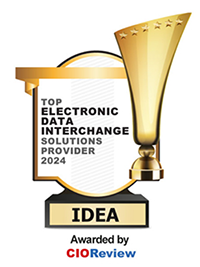Five EDI Transaction Sets to Improve Your Operations
Week #3 of IDEA’s EDI Masterclass: Your Ultimate Guide to Streamlining Business Processes with Electronic Data Interchange
By Tom Guzik, Director, Digital Integration Services, IDEA

So, you read our last article, and you’ve implemented the five foundational Electronic Data Interchange (EDI) transactions. Your staff is happy. Your operational costs are down. You’ve even freed up space you’d been using to store envelopes. You got a taste for EDI efficiency and you want to automate every document. Of the 318 remaining EDI transaction sets, these five are top priority to smooth any existing clunky processes and set your business up for continued growth.
1. EDI Payment Order/Remittance Advice (820)
A critical document for businesses engaging in electronic funds transfers (EFT) and automated clearing house (ACH) payments, this transaction seamlessly transfers payment and remittance information between trading partners.
Benefits:
- Automatic Payment Reconciliation: The EDI 820 provides suppliers with all the necessary details to reconcile payments against invoices, including whether an invoice was paid in full or if any credits or deductions were applied. This level of detail significantly reduces the time and effort required for reconciliation. Recently, a major lighting manufacturer using IDEA Exchange implemented the EDI 820 and cut the time spent reconciling a large retailer’s payment from four days per month to just two hours!
- Reduced Errors and Manual Effort: Automation minimizes manual errors that occur with traditional payment methods, which is particularly beneficial for companies dealing with big-box retailers or those affiliated with distributor groups like Affiliated Distributors (AD).
2. EDI Motor Carrier Shipment Status Message (214)
Motor freight carriers use this document to manage and improve complex supply chains by communicating real-time updates on shipment pick-up, departure times, stops along the route, and the final delivery status.
Benefits:
- Dispute Prevention: The EDI 214 provides proof of delivery, including details on who signed for the shipment and the condition of the goods upon arrival. This helps prevent disputes and surprise credit requests due to damaged or missing items.
- Logistical Improvements: By analyzing the data provided in the EDI 214, companies can assess their shipping performance and identify areas for improvement.
3. EDI Product Transfer Account Adjustment (844)
Distributors can automate rebate requests — a traditionally time-consuming and paper-intensive process — by sending this document to manufacturers to report sales that qualify for vendor rebates.
Benefits:
- Reduced Overhead: By automating this process, businesses can reduce administrative burden and free up employees to focus on revenue-generating activities.
- Error Reduction: The EDI 844 sends all relevant sales data to the manufacturer, facilitating timely, accurate rebate payments.
4. EDI Response to Product Transfer Account Adjustment (849)
Also known as the chargeback reconciliation document, this document is the manufacturer’s response to the EDI 844 rebate request, providing the manufacturer-approved rebate amounts and any adjustments to the distributor’s request.
Benefits:
- Faster Rebate Cycle: When used in conjunction with the EDI 844, the EDI 849 creates a fully automated rebate process. This not only expedites the rebate cycle, but ensures all parties have accurate, up-to-date information regarding rebate payments.
- Financial Record Accuracy: The EDI 849 allows distributors to update their systems with the final rebate amounts, reducing discrepancies and ensuring records reflect the actual rebates received.
5. EDI Product Activity Data (852)
This versatile document conveys detailed product activity information, including inventory levels, product sales, and forecasts, so suppliers can manage inventory replenishment.
Benefits:
- Optimized Inventory Management: In a Vendor Managed Inventory (VMI) setup, this comprehensive data helps suppliers keep distributor warehouses stocked with the right products at the right time, minimizing stockouts and excess inventory.
- Data-Driven Decision Making: The EDI 852 supports advanced analytics and accurate demand forecasting by providing data on sales trends and inventory turnover by region, store type, or time period.
EDI Automation + Data = Future Success
Doing more with data isn’t just IDEA’s slogan; it’s the mantra that must underly all business operations to compete in the future. Implementing these five transaction sets provides better data on everything from rebates to logistics to inventory, empowering your team with knowledge to make better decisions.
If you have any questions about EDI or would like to learn more about how to implement these transactions, please contact your IDEA Exchange Account Executive or Ilene Bromberg at 703-562-4689 or ibromberg@idea4industry.com. We look forward to helping you unlock the full potential of your business with EDI.

Looking for the previous Masterclass articles?
- Week #1: Electronic Data Interchange (EDI): More Than Purchase Orders and Invoices
- Week #2: Five Foundational EDI Transactions in IDEA Exchange to Maximize ROI
